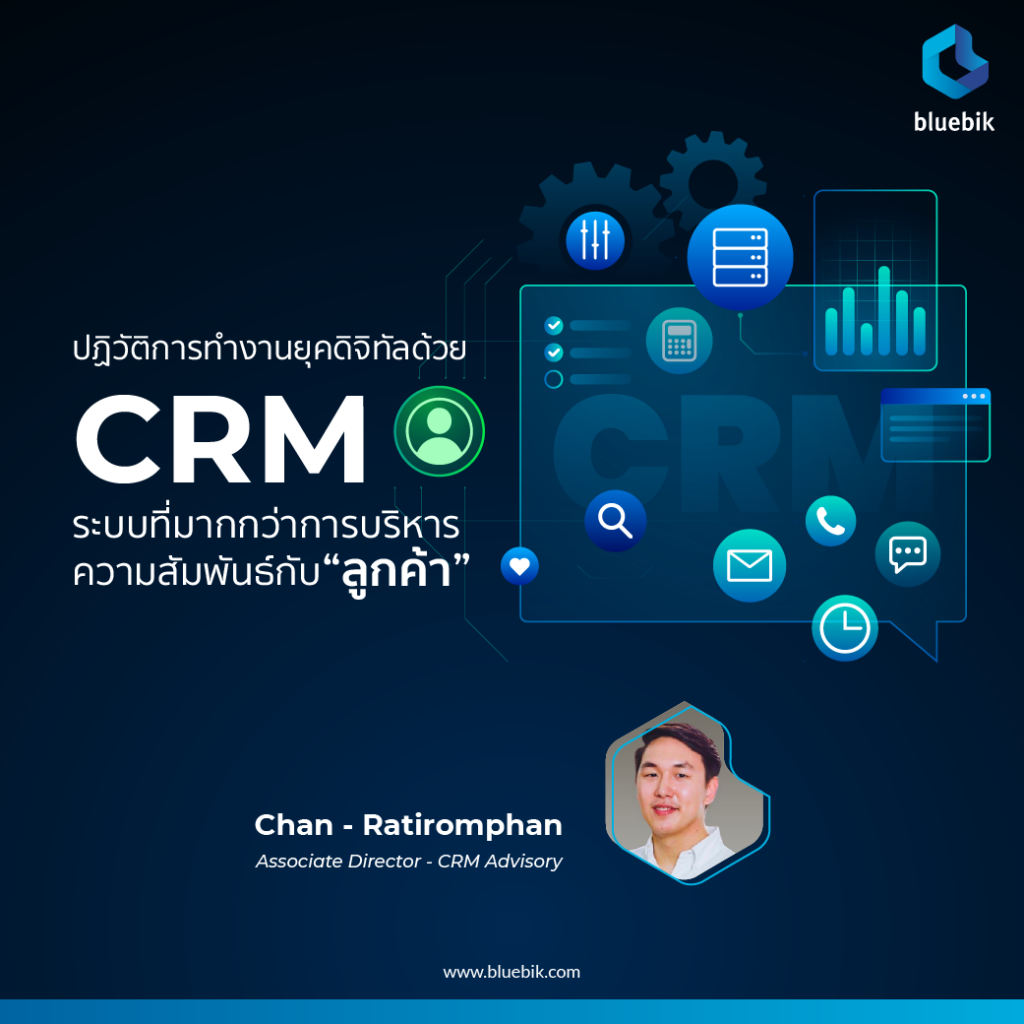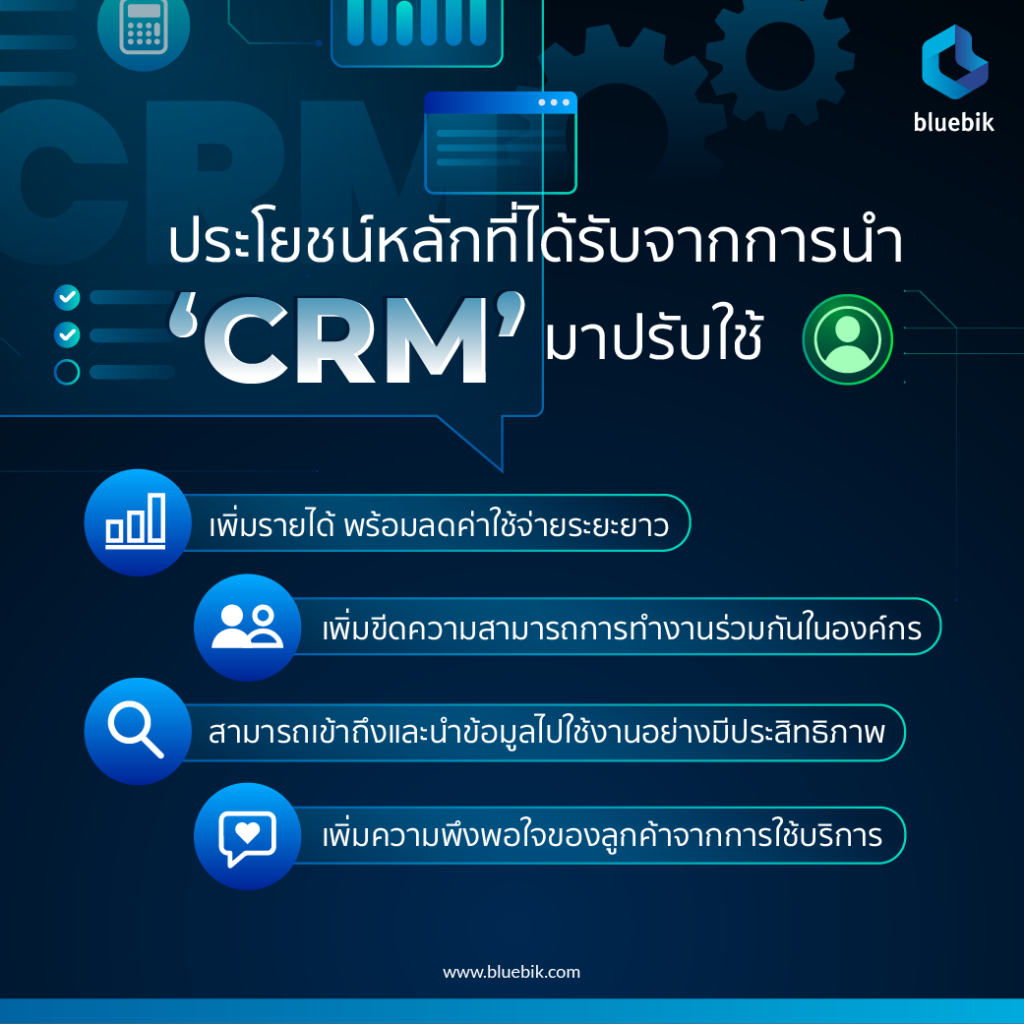เมื่อพูดถึงคำว่าระบบ Customer Relationship Management หรือ CRM คนส่วนใหญ่มักจะนึกถึงระบบไอที ที่สร้างขึ้นเพื่อบริหารความสัมพันธ์กับลูกค้า ยิ่งไปกว่านั้น ระบบ CRM ยังถูกมองว่า เป็นระบบที่มีความซับซ้อน เพราะเกี่ยวข้องกับหลายฝ่ายในองค์กร และมีค่าใช้จ่ายที่ค่อนข้างสูง อีกทั้งวัดผลการตอบแทนจากการลงทุน (Return on Investment: ROI) ได้ยาก และเหมาะสำหรับองค์กรขนาดใหญ่เท่านั้น
โดยข้อเท็จจริงแล้ว ระบบ CRM สามารถนำไปใช้งานได้มากกว่าการบริหารความสัมพันธ์กับลูกค้า เพราะการใช้งานระบบ CRM สามารถครอบคลุมถึงผู้ที่มีส่วนได้ส่วนเสีย (Stakeholder) อื่น ๆ ที่เกี่ยวข้องทางธุรกิจ อาทิ ลูกค้าที่มีแนวโน้มจะซื้อหรือใช้บริการ (Potential Customer) ผู้ผลิต (Supplier) พนักงานในองค์กร (Employee) และพันธมิตรทางธุรกิจ (Business Partner) เป็นต้น โดยมีจุดประสงค์หลัก เพื่อให้องค์กรสามารถปฏิสัมพันธ์กับกลุ่มบุคคลเหล่านี้ ได้อย่างมีประสิทธิภาพมากยิ่งขึ้น

การปฏิวัติการดำเนินงานด้วยระบบ CRM ในองค์กร
การนำระบบ CRM มาใช้งาน ควรจัดให้เป็นส่วนหนึ่งของทิศทางกลยุทธ์ขององค์กร มากกว่าการนำระบบไอทีมาติดตั้ง เพราะต้องมีการออกแบบกระบวนการทำงานใหม่ เพื่อให้คนในองค์กรหรือผู้ที่เกี่ยวข้องสามารถทำงานร่วมกันได้อย่างมีประสิทธิภาพ และบรรลุวัตถุประสงค์ในการขับเคลื่อน Value ไปยังกลุ่มลูกค้าเป้าหมายรวมถึงตัวองค์กร โดยมีระบบ CRM เป็นกลไกสำคัญในการขับเคลื่อนนี้
ดังนั้นการประเมินผลลัพธ์จากการนำระบบ CRM มาปรับใช้ จึงควรมองภาพใหญ่และพิจารณาถึงค่าเสียโอกาส (Opportunity Cost) หากไม่นำระบบ CRM มาใช้งาน มากกว่าเรื่องของผลตอบแทนจากการลงทุนในการนำระบบงานมาใช้ นอกจากนี้ ระบบ CRM ยังสามารถปรับใช้กับองค์กรได้หลายขนาด ครอบคลุมตั้งแต่องค์กรขนาดเล็กจนถึงขนาดใหญ่ ซึ่งขึ้นอยู่กับทิศทางขององค์กร กระบวนการทำงานตามลักษณะเฉพาะของธุรกิจ
หากองค์กรมีการเลือกใช้ระบบ CRM ที่เหมาะสมกับการใช้งาน และมีความเข้าใจที่ถูกต้องเกี่ยวกับระบบ CRM จะพบว่า ระบบ CRM สามารถเพิ่มขีดความสามารถในการแข่งขัน และปรับปรุงประสิทธิภาพในการดำเนินงานให้ดีขึ้นได้อย่างไร้ข้อกังขา ด้วยเหตุนี้ การปฏิวัติการดำเนินงานด้วยระบบ CRM จึงเป็นอีกหนึ่งกลไกสำคัญของกระบวนการเปลี่ยนผ่านองค์กร เข้าสู่การทำธุรกิจในยุคดิจิทัล
ทำไมต้องใช้ระบบ CRM ในภาคธุรกิจ
ระบบ CRM จะเข้ามาช่วยให้ภาคธุรกิจ สามารถบริหารจัดการการปฏิสัมพันธ์ระหว่างองค์กรกับผู้มีส่วนได้ส่วนเสีย และลูกค้า ด้วยการสร้างความใกล้ชิดและสัมพันธ์อันดีในระยะยาว ผ่านการจัดเก็บและประมวลข้อมูลของระบบ CRM จนได้ Data Insight ที่เข้ามาช่วยปรับปรุงบริการ ตั้งแต่ต้นน้ำถึงปลายน้ำให้ตรงตามความต้องการของลูกค้า รวมถึงการเพิ่มประสิทธิภาพการบริหารจัดการการทำงานให้เป็นระบบ รวดเร็ว และสามารถประเมินผลได้อย่างชัดเจน
ดังนั้นการใช้งานระบบ CRM จะทำให้ภาคธุรกิจ สามารถดำเนินงานภายใต้หลักปฏิบัติที่ถูกต้องในช่องทาง และช่วงเวลาที่เหมาะสม พร้อมทั้งเห็นข้อมูลที่จำเป็นอย่างครบถ้วน ทั้งในส่วนของงานขาย งานบริการ การตลาด และเรื่องอื่น ๆ ที่เกี่ยวข้อง โดยองค์กรสามารถเข้าถึงข้อมูลบนระบบ CRM ที่จัดเก็บทุกอย่างอยู่ในรูปแบบและฐานข้อมูลดิจิทัล ให้สามารถนำข้อมูลไปใช้งานผ่าน Tracking Report Dashboard รวมถึงสื่อสารและบริหารความคาดหวังของลูกค้าได้อย่างมีประสิทธิภาพ ด้วยข้อมูลที่มีรายละเอียดเชิงลึก
การปรับใช้ระบบ CRM มีประโยชน์อย่างไร
1. เพิ่มรายได้และลดค่าใช้จ่ายการดำเนินการในระยะยาว
การใช้ระบบ CRM เข้ามาช่วยในการปรับเปลี่ยนกระบวนการทำงาน ทำให้ลดขั้นตอนและระยะเวลาในการดำเนินงาน ช่วยลดค่าใช้จ่ายด้านทรัพยากรบุคคลลง และเพิ่มโอกาสทางธุรกิจใหม่ ๆ มากขึ้น
2. เพิ่มขีดความสามารถในการดำเนินงานร่วมกันภายในองค์กร
แต่ละหน่วยงานสามารถเห็นข้อมูลที่จำเป็นจากแผนกอื่น ๆ ที่อยู่บนระบบเดียวกันได้แบบเรียลไทม์ ทำให้การดำเนินงานหรือการตัดสินใจทำได้รวดเร็วขึ้น และลดข้อผิดพลาดที่อาจเกิดขึ้นจากการสื่อสารผิดพลาดระหว่างกันได้ นอกจากนี้ ระบบ CRM ของหลายบริษัทได้นำเสนอระบบในรูปแบบ Low Code – No Code ทำให้องค์กรสามารถดำเนินการ หรือสามารถปรับเปลี่ยนกระบวนการทำงานได้เร็วขึ้น เนื่องจากแพลตฟอร์มดังกล่าว ช่วยลดการพึ่งพาบุคลากรฝ่ายไอที
3. สามารถเข้าถึงข้อมูลและนำข้อมูลไปใช้งานได้อย่างมีประสิทธิภาพ
ข้อมูลทั้งหมดที่ผ่านระบบ CRM จะมีการแปลงข้อมูลให้อยู่ในรูปแบบดิจิทัล ทำให้ผู้ใช้งานสามารถเรียกใช้ข้อมูลได้ทันทีที่ต้องการ นอกจากนี้ ยังสามารถนำข้อมูลไปใช้วิเคราะห์ผ่าน Data Analytics Module เพื่อทำรายงาน หรือ Dashboard เป็นข้อมูลประกอบการตัดสินใจ และวางแผนงานให้แก่ผู้บริหาร
4. เพิ่มความพึงพอใจของลูกค้าจากการใช้บริการ
ความสามารถในการเข้าถึงข้อมูลที่ครบถ้วนแบบเรียลไทม์ รวมถึงการบริหารจัดการกระบวนการภายในต่าง ๆ ที่มีประสิทธิภาพมากขึ้น ทำให้องค์กรสามารถตอบสนองความต้องการของลูกค้าได้อย่างรวดเร็ว มีประสิทธิภาพ และตรงตามความคาดหวังได้อย่างแม่นยำ

ถอดรหัสข้อผิดพลาดจากการนำระบบ CRM ไปใช้ผิดวิธี
1. ไม่ทำความเข้าใจลูกค้าหรือผู้ใช้งานให้ชัดเจน ก่อนติดตั้งระบบ CRM
ทำให้สุดท้ายไม่สามารถนำไปใช้งานจริงได้ เพราะระบบไม่ได้ถูกออกแบบให้ตรงตามความต้องการของผู้ใช้งานจริงตั้งแต่แรก
2. นำระบบ CRM มาใช้งานจริง โดยที่ไม่มีการปรับตัวโครงสร้างการทำงานให้เหมาะสม
ทำให้การนำระบบ CRM ไม่สามารถสร้างความเปลี่ยนแปลงในการทำงานขององค์กรได้อย่างที่ควรจะเป็น ด้วยเหตุนี้ เมื่อมีการนำระบบ CRM มาใช้งานจริงจำเป็นต้องมีการปรับโครงสร้างการทำงานให้สอดรับกับระบบใหม่ เพื่อป้องกันการทำงานที่ทับซ้อนกับกระบวนการเก่า ๆ
3. คิดว่ายิ่งมีระบบ CRM เยอะยิ่งดี
แม้ว่าระบบ CRM จะช่วยให้การทำงานต่าง ๆ สะดวกและง่ายขึ้น แต่นั่นไม่ได้หมายความว่าการที่เรายิ่งมีเครื่องมือจำนวนมากจะทำให้การทำงานรวดเร็วขึ้น เพราะหัวใจสำคัญของการใช้ระบบ CRM คือ การปรับใช้อย่างเหมาะสม และตามความจำเป็นที่สอดคล้องกับทิศทางกลยุทธ์ เพื่อก่อให้เกิดประโยชน์สูงสุดกับองค์กร
4. ใช้รูปแบบการทำงาน CRM แบบเดียวกันกับลูกค้าและผู้ใช้งานทุกกลุ่ม
เนื่องจากผู้ใช้งานแต่ละฝ่ายหรือลูกค้าแต่ละกลุ่ม มีความต้องการและมีลักษณะที่แตกต่างกัน ดังนั้นการใช้งานระบบ CRM จำเป็นต้องมีการปรับเปลี่ยนรูปแบบให้สอดคล้องตามความต้องการเหล่านั้นด้วยเช่นกัน
5 ขั้นตอนเบื้องต้นในการนำระบบ CRM มาปรับใช้ในองค์กร
1. กำหนดขั้นตอนการดำเนินงานในการนำ CRM ไปใช้องค์กร เพื่อให้เห็นภาพรวมและความเชื่อมโยงของการทำงานภายในองค์กร
2. ระบุกลุ่มผู้ใช้งานและผู้ที่เกี่ยวข้อง ที่ต้องใช้ระบบ CRM ในการดำเนินงาน
3. ระบุจุดที่อาจเป็นปัญหาในการดำเนินงาน และมีความจำเป็นหรือเร่งด่วนในการปรับเปลี่ยน
4. ตั้งเป้าหมายที่เป็นไปได้ในการพัฒนาผ่านการนำระบบ CRM เข้ามาใช้ในการดำเนินงาน
5. เลือกระบบ CRM ที่เหมาะสมกับความต้องการ เพื่อนำมาปรับใช้ภายในองค์กร เช่น องค์กรขนาดใหญ่ที่มีความซับซ้อน และมีจำนวนผู้ใช้งานที่ต้องทำงานร่วมกันมาก อาจพิจารณาเลือกใช้ระบบ CRM ของแบรนด์ใหญ่ในตลาดที่มีฟีเจอร์หลากหลาย เพื่อรองรับการทำงานหลายรูปแบบขององค์กร รวมถึงความสามารถในการรองรับปริมาณการใช้งาน (Transaction) จำนวนมาก ยกตัวอย่างผู้ให้บริการ CRM รายใหญ่ ๆ อาทิ Salesforce หรือ Dynamics 365 จาก Microsoft และ SAP CRM เป็นต้น
ระบบ CRM ถือเป็นเครื่องมือที่ช่วยให้องค์กรบรรลุเป้าหมายเชิงกลยุทธ์ที่วางไว้ได้รวดเร็วมากยิ่งขึ้น ด้วยเหตุนี้การปรับเปลี่ยนมุมมองใหม่ที่มีต่อระบบ CRM อย่างมีวิสัยทัศน์จึงเป็นสิ่งสำคัญ การพิจารณานำระบบ CRM มาใช้งานด้วยการวัดผลลัพธ์นั้น ควรคำนึงถึงปัจจัยโดยรอบ ทั้งในแง่รายได้ ระยะเวลา และค่าเสียโอกาส เพราะการทำธุรกิจในปัจจุบันนี้ เพียงแค่เข้าใจยังไม่พอ แต่ต้องเข้าถึง “ใจ” (ลูกค้า) ด้วย ถึงจะเป็นผู้ที่อยู่รอดอย่างแข็งแกร่ง ท่ามกลางโลกธุรกิจในยุคดิจิทัลที่มี “ลูกค้าเป็นศูนย์กลาง (Customer Centric)” และมีความเปลี่ยนแปลงอย่างรวดเร็วได้
สำหรับธุรกิจที่ต้องการวางกลยุทธ์การนำระบบ CRM มาปรับใช้ในองค์กร เพื่อเพิ่มศักยภาพการแข่งขันและสร้างการเติบโตให้องค์กร ‘บลูบิค (Bluebik)’ มีทีมงานผู้เชี่ยวชาญด้าน Management Consulting ที่สามารถให้บริการโซลูชันครบวงจร และการวิเคราะห์ข้อมูลขั้นสูง ตั้งแต่ระดับกลยุทธ์ไปจนถึงการนำไปปรับใช้ให้เหมาะสมกับองค์กร ผู้สนใจสามารถติดต่อสอบถามหรือปรึกษาได้ที่ [email protected] หรือโทรศัพท์ 02-636-7011












